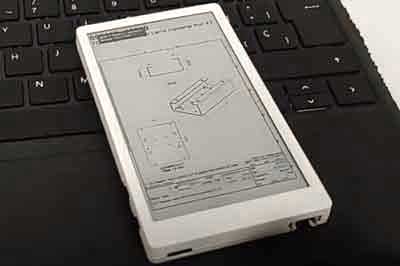The weekend has arrived and it’s time to share a new project with the M5Paper, to see what we can get out of this little machine.
As I mentioned in the previous post, one of the main interests I had in this great device was the potential I see in IoT applications and, especially, in industry 4.0.
In particular, one of the things I was most eager to try was displaying blueprints or other graphic information loaded from an ERP / PDM / PLM (… or whatever acronym you prefer).
Some may think, but isn’t one of the goals of industry 4.0 to minimize or eliminate blueprints? Yes, that’s true, and that’s where we should be heading. But, today, many companies still need blueprints, and they need them during manufacturing or installation.
The new generations of e-ink have enough detail to display complex graphics. Combined with their ease of reading and low consumption, they can be a good alternative for the transition to a manufacturing process without blueprints.
But most importantly, it’s going to be a lot of fun. So let’s get to work, and here’s the result.
For that, your system has to store the blueprint (or other document) in a format, for example, a PDF, in the native CAD format, a Word. How does the M5Stack process this information? Well, here’s the “trick” (or the genius), it doesn’t.
The ESP32 has the power for many things, but not for rendering a PDF (I believe, someday we have to try it). It can decompress a JPG format, decompress a ZIP file, even an MPEG video. But it has its limits.
Good news, it’s not necessary either. In any case, we need a client application that connects to the system, accesses the database, etc. So, since we have it, we can use it to do all the “heavy lifting” of rendering.
The C# application is responsible for opening the blueprint in whatever format it is, converting it into a 16-bit 960 x 540 grayscale image, performing any other necessary processes, and sending the compressed information to the M5Paper.
As you can see, the result is very good, both in terms of visualization detail and response time. Since the image has 4 bits per pixel, the information sent is not very large, and the response is very fast.
It’s easy to imagine a device at every folding machine, welding station, assembly carts, warehouses, etc… So here’s this project for you to use as inspiration. Until next time!
